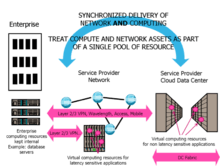Carrier cloud
In cloud computing a carrier cloud is a class of cloud that integrates wide area networks (WAN) and other attributes of communications service providers’ carrier grade networks to enable the deployment of highly demanding applications in the cloud. In contrast, classic cloud computing focusses on the data center, and does not address the network connecting data centers and cloud users. This may result in unpredictable response times and security issues when business critical data are transferred over the Internet.
History
The advent of virtualization technology and cost effective computing hardware as well as ubiquitous Internet connectivity enabled a first wave of cloud services starting in the first years of the 21st century.[1][2][3][4]
But many businesses and other organizations hesitated to move more demanding applications from on-premises dedicated hardware into private or public clouds. As a response, communications service providers started in the 2010/2011 time frame to develop carrier clouds that address perceived weaknesses in existing cloud services.[5] Weaknesses cited vary[6][7][8][9] but often include performance, availability, security and service level agreements (SLAs).
Characteristics
To enable the deployment of time-sensitive and business critical applications in the cloud, the carrier cloud is designed to match or even exceed the characteristics of on-premises deployments. Therefore, the carrier cloud is characterized by some or all of the following items:
- Configurable, elastic network performance: Typical cloud computing solutions use the best effort public Internet to connect cloud users and data centers. This approach provides instant connectivity but does not offer control over network capacities, latencies, and jitter. Carrier clouds address these gaps with content delivery networks and/or dedicated virtual private networks (VPN) at OSI layers 1 (optical wavelengths), 2 (data link layer), and 3 (network layer). These VPNs can be configured to offer the desired performance parameters and exhibit the same type of elasticity for the network that regular clouds provide for servers and storage. To achieve the requested performance parameters, such as low latency, cloud applications can be (automatically) allocated to distributed data centers that are close enough to the cloud users.
- Automatic resource placement: For a cloud with multiple data centers, information about both, the data center and the connecting network, is relevant for a decision where to place cloud images and storage volumes. For this decision, carrier clouds can obtain relevant information about the network, e.g., using the Application-Layer Traffic Optimization (ALTO) protocol.[10]
- High level of security and governance: Cloud application providers are subject to general and domain specific security, privacy, and governance requirements and regulations, such as the European Data Protection Directive and the U.S. Health Insurance Portability and Accountability Act. For added security, the wide area network of the carrier cloud can provide segregated encrypted or unencrypted network links that are not accessible from the general Internet. At the data center, the carrier cloud provides e.g. virtual private servers, management processes, logs and documentation to fulfill security and governance rules.
- Location control: Fundamentally, cloud users should not be concerned with the geographic location of their cloud resources. However, privacy and other regulations may mandate that certain types of data must not be sent outside a national jurisdiction or other geographical region.
- Open APIs: Carrier clouds provide graphical user interfaces and Web application programming interfaces that allow cloud application providers to set up, manage, and monitor both, the data center and the WAN, of their cloud services.
Architecture
Carrier clouds encompass data centers at different network tiers and wide area networks that connect multiple data centers to each other as well as to the cloud users. Links between data centers are used, for instance, for failover, overflow, backup, and geographic diversity. Carrier clouds can be set up as public, private, or hybrid clouds. The carrier cloud federates these cloud entities, using a single management system to orchestrate, manage, and monitor data center and network resources as a single system.

References
- ↑ Public IT Cloud Services Spending to Reach $72.9 Billion in 2015, Capturing Nearly Half of Net New Spending Growth in Five Key Product Segments, According to IDC, June 20, 2011
- ↑ Gartner Says Worldwide IT Spending Is on Pace to Grow 7.1 Percent in 2011, Gartner June 30, 2011
- ↑ Public cloud services market to hit revenues of $66 billion, September 30, 2011
- ↑ Cloud Computing Takes Off: Market Set to Boom as Migration Accelerates, Morgan Stanley, May 23, 2011
- ↑ Cloud Services: Carriers Want Cloud Control, CRN, July 25, 2011
- ↑ IDC Cloud Management Forecast 2011: Survey on CIO Attitudes, IDC, 2011
- ↑ Empty Promises and Tough Luck: Yankee Group Exposes the Cloud's Fine Print, Yankee Group, April 21, 2010
- ↑ Guidelines on Security and Privacy in Public Cloud Computing, National Institute of Standards and Technology, January 2011
- ↑ Performance issues cloud content delivery options, Jeff Kim, ECM Plus: The Voice of Content, April 21, 2011
- ↑ RFC 5693: Application-Layer Traffic Optimization (ALTO) Problem Statement